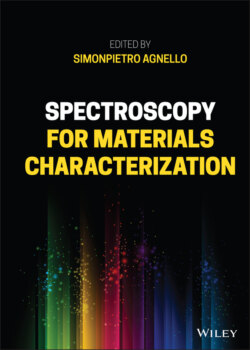Читать книгу Spectroscopy for Materials Characterization - Группа авторов - Страница 37
2.1.3 Zero‐Phonon Line
ОглавлениеOptical transitions in which the vibrational state of the system does not change are called purely electronic transitions or zero‐phonon transitions, since they occur without creation or annihilation of phonons; in this case, absorption and luminescence are resonant [6]. An example of purely electronic absorption is shown in the configuration coordinate (q s ) diagram of Figure 2.2: E 00, E 11, and E 22 represent the energies of the 0 → 0, 1 → 1, and 2 → 2 transitions. In general, W I, s (q s ) and W II, s (q s ) have different curvatures (ℏω I, s ≠ ℏω II, s ), then the purely electronic transitions do not occur at the same energy and are different from ε 0: E 00 ≠ E 11 ≠ E 22 ≠ ε 0. In the linear electron–phonon coupling approximation (ℏω I, s = ℏω II, s ), all the zero‐phonon transitions have the same energy (E 00 = E 11 = E nn ) coinciding with ε 0. In this case, the spectrum evidences a single line called Zero‐Phonon Line (ZPL) of energy E 00 = ℏω 0, which is due to the superposition of a set of lines arising from transitions between different pairs of vibrational levels. Therefore, ZPL lies exactly at the energy of the purely electronic transition and is independent of temperature.
Ideally, ZPL has zero width and its shape is accounted for by the δ‐function:
(2.17)
In reality, ZPL has a finite width due to the lifetime τ of the excited electronic state; δ‐function in Eq. (2.17) is, therefore, replaced by a Lorentzian curve with full width at half maximum (FWHM) of (ℏ/τ):
(2.18)
The zero‐phonon transition probability for each configuration coordinate q s is:
(2.19)
Figure 2.2 Configuration coordinate diagram where are depicted the zero‐phonon transitions 0 → 0, 1 → 1, and 2 → 2.
where the vibrational levels of the electronic states I and II coincide (n s = m s ). According to Eq. (2.9), the total probability is given by:
(2.20)
To calculate the temperature dependence of the ZPL intensity, I ZPL(T), we have to average over the Boltzmann distribution to account for the thermal population of the vibrational levels n s :
(2.21)
A is a constant independent of the frequency, is the electron matrix element in the Condon approximation, F(T) is the normalizing factor of the Boltzmann's distribution function, k is the Boltzmann's constant (k≅1.381 × 10−23 J⋅K−1), ω I, s is the frequency of the sth normal mode in the electronic state I, and [n] represents all the possible sets n s .
First, only the contribution of the band vibrations is considered. As discussed above, the equilibrium positions of the electronic states I and II in the configuration coordinate q s differ for an infinitesimal quantity Δq s , whereas the oscillator frequencies do not change, (ω I, s = ω II, s = ω s ). The relationship between the vibrational wave functions is therefore:
(2.22)
The overlap integral in Eq. (2.21) becomes:
(2.23)
where we have account for the properties of orthonormality and symmetry of the vibrational functions. The remaining integral can be expressed in terms of the average kinetic energy:
(2.24)
where is the kinetic energy averaged over the nth state of the sth oscillator and M s is the nuclear mass defined in the normal mode s. According to the virial theorem:
(2.25)
the overlap integral is:
(2.26)
and its square is
(2.27)
where the terms of the order of are neglected.
To solve Eq. (2.21), because of the independence of normal modes, the states of the oscillator 1 are separated from the remaining set n and are averaged over them:
(2.28)
The asterisks on the indices n and on the normalizing factor F(T) mean that the oscillator 1 is excluded from the set. The first factor in Eq. (2.28) becomes:
(2.29)
E 1(T) is the average thermal energy of a linear harmonic oscillator:
(2.30)
where is the average quantum number of the oscillator 1. The same algorithm is applied on the states of other oscillator numbers and after a bit of algebra, the integrated intensity of ZPL is found to be:
(2.31)
where T s is the effective temperature of a harmonic oscillator:
(2.32)
It is useful to introduce the dimensionless parameter, called Huang Rhys factor [12], for the band vibrations:
(2.33)
The physical meaning of the Huang Rhys factor has been introduced in the previous chapter. According to Eq. (2.33), equals the difference between the absorption energy E A (vertical distance from the minimum of W I, s (q s ) to W II, s (q s )) and the luminescence energy E L (vertical distance from the minimum of W II, s (q s ) to W I, s (q s )). The difference between E A and E L is the so‐called Stokes shift, is therefore:
(2.34)
it gives the amount of the vibrational relaxation energy in units of the vibrational quantum.
After introducing , the expression for I ZPL(T) can be rewritten as:
(2.35)
At low temperature, namely kT ≪ ℏω s , coth(ℏω s /2kT) → 1 or T s → (ℏω s )/2k and I ZPL(T) becomes:
(2.36)
that increases with decreasing the total Huang Rhys factor, . At high temperature, namely kT ≫ ℏω s , coth(ℏω s /2kT) → 2kT/ℏω s or kT s → kT and the expression for I ZPL(T) becomes:
(2.37)
In this case, I ZPL(T) decreases exponentially with increasing temperature and drops faster the larger is the Huang Rhys factor.
